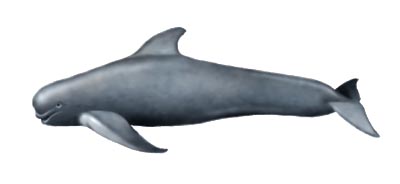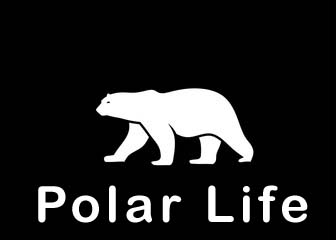Long-finned Pilot Whale, Globicephala melaena
Pilot whales gain their common name from their ability to closely track the movements of large schools of squid. Fishermen used visual sightings of these cetaceans coming to the surface to guide them either to fishing or squid jigging grounds.
Pilot whales are the second largest member of the dolphin family, just behind the orca in size and length. On average, males grow to a length of 5.7 m and weigh up to 2.3 tonnes. They can be easily recognized by their dark brown to black colouration, their protruding forehead, and almost imperceptible beak. Its beak and bulbous head help this dolphin capture its favourite food, squid. The beak is used to hold onto a slippery squid while the bulbous head contains fat that may focus its echolocation signals, which are used to find prey.
Squid are extremely important to the survival of the pilot whale, so much so that the species has no set migration pattern, but instead follows schools of squid throughout the year. The squid species most heavily fed upon, Illex illecebrosus, moves towards shore during the early summer months to feed on capelin, herring, and mackerel, and pilot whales follow them. In an average year, a single pilot whale may eat 10 tonnes of I. illecebrosus! Pilot whales are highly social, assembling in massive numbers, with as many as 1000 individuals in a single pod. Once together, these herds exhibit highly coordinated movements and hunting behaviour.
It is this coordination that may result in the mass death of hundreds of individuals from beaching. If one or two individuals throw themselves on a beach, large portions of the herd may follow. Exactly why the first individuals beach themselves is not known, but theories suggest it may be disorientation due to storms, parasites disrupting sonar navigation, frenzied feeding, or stress-induced suicide. In fact, beach stranding is the largest natural cause of death in this species.
Humans have exploited pilot whales for a long time, both for food and for profit. During the 1950s, meat from slaughtered pilot whales was sold to mink farmers for a penny a pound. Before that, a thriving fishery in the North Sea, centred around the Faroe Islands in Scotland, lasted hundreds of years. In Canada, whaling was banned in 1972, but small fisheries, including those of First Nations peoples, have continued to take small numbers. Pilot whale populations have rebounded because of this ban and the species is no longer considered endangered. In the last few years, researchers have found that the meat and fat of pilot whales contains very high amounts of mercury, cadmium, and polyfluorocarbons (PCBs).

